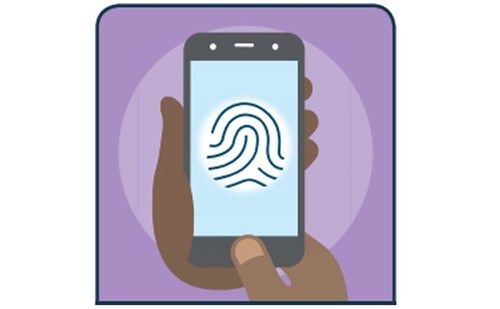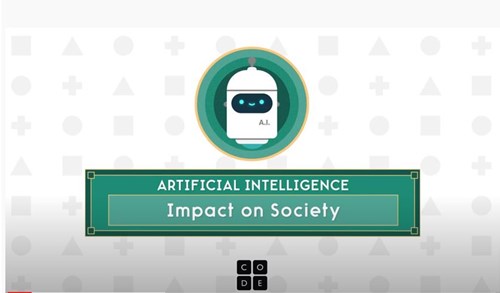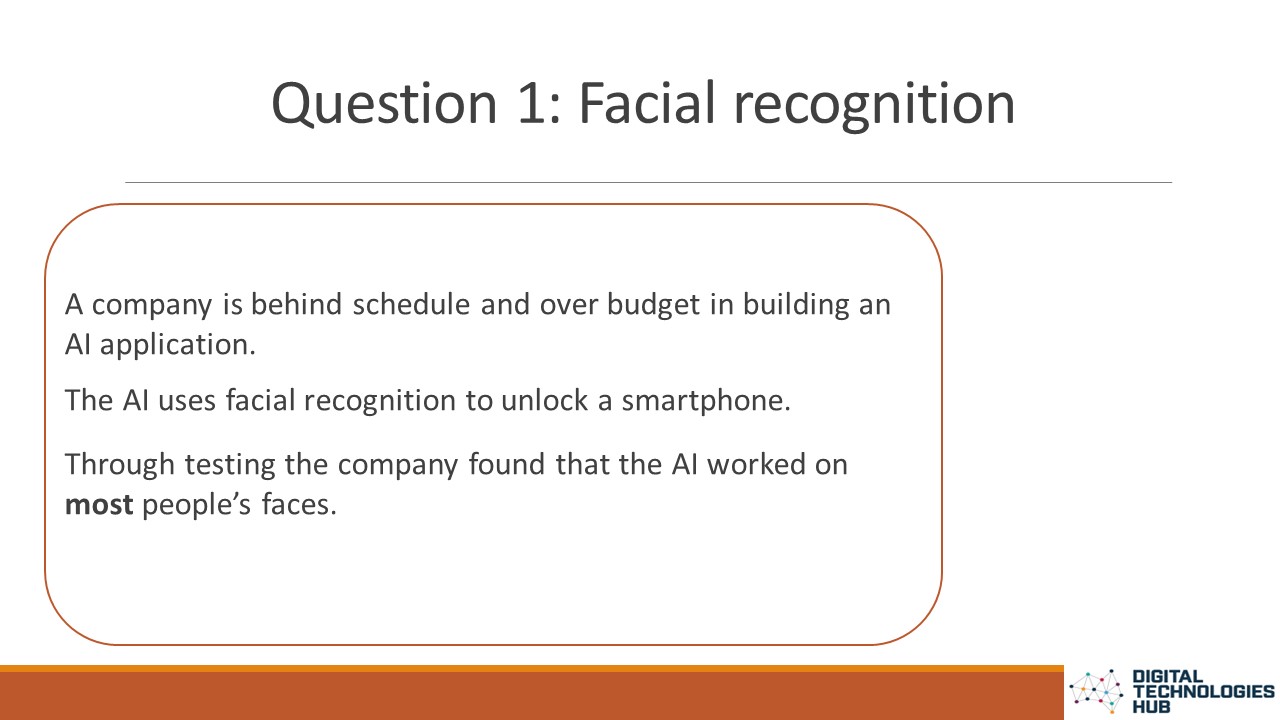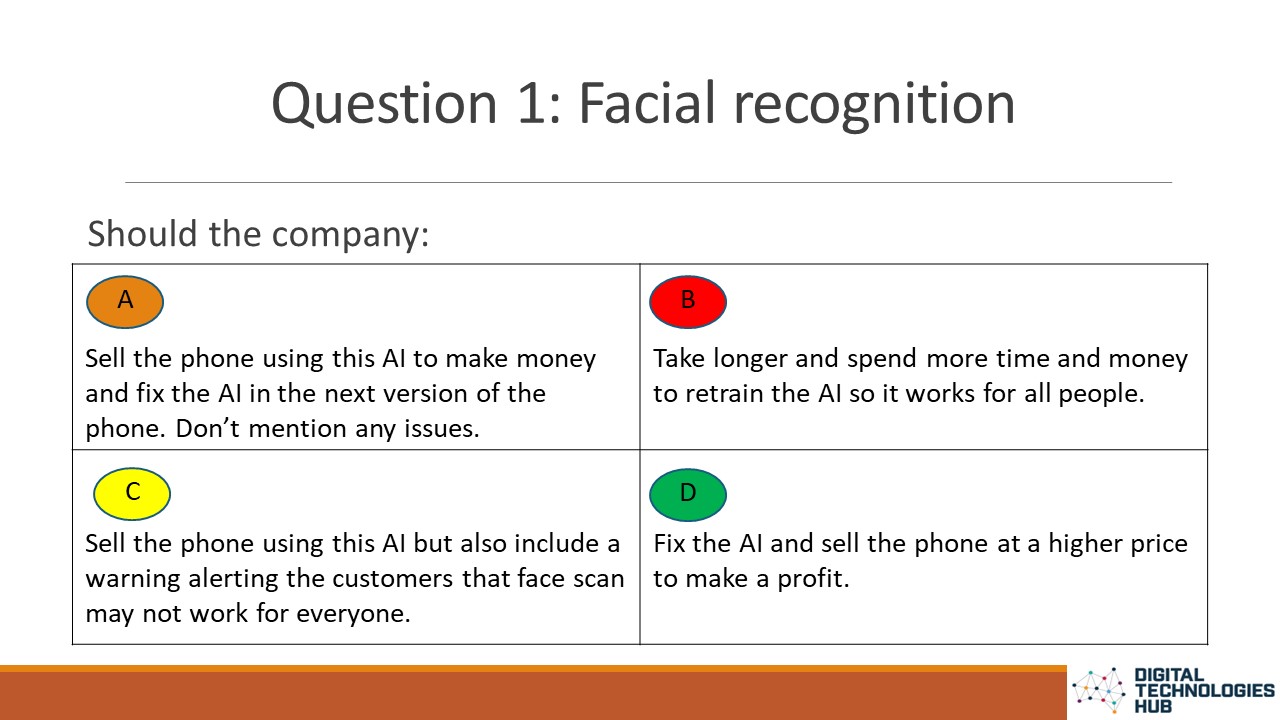AI Quiz

About this lesson
This lesson provides an opportunity for students to draw on their ethical understanding when asked to respond to different scenarios. The scenarios feature information systems that incorporate an AI application. Students are given four options to select which one they believe to be the ‘right’ thing to do. Students develop a set of guidelines for ethical AI development.
Year band: 5-6, 7-8
Curriculum Links AssessmentCurriculum Links
Links with the Digital Technologies Curriculum Area.
| Year | Content Description |
|---|---|
| 5-6 |
Evaluate existing and student solutions against the design criteria and user stories and their broader community impact (AC9TDI6P06) |
| 7-8 |
Evaluate existing and student solutions against the design criteria, user stories and possible future impact (AC9TDI8P10) |
Ethical Understanding
Typically, by the end of Year 6, students:
Recognise ethical concepts
- Examine and explain ethical concepts such as truth and justice that contribution to the achievement of a particular outcome.
Reason and make ethical decisions
-
Explore the reasons behind there being a variety of ethical positions on a social issue.
Evaluate the consequences of actions in familiar and hypothetical scenarios.
Examine values
- Examine values accepted and enacted within various communities.
Typically, by the end of Year 8, students:
Explore ethical concepts in context
- Analyse the ethical dimensions of beliefs and the need for action in a range of setting.
Reason and make ethical decisions
-
Analyse inconsistencies in personal reasoning and society ethical decision making.
Examine values
- Assess the relevance of beliefs and the role and application of values in social practices.
Source: Australian Curriculum, Ethical Understanding general capability
Assessment
Teacher assessment
Assess against these elements of the achievement standard for the relevant year level. Note ‘needs’ can include the ethical needs of a community.
| Level | Achievement standard |
|---|---|
|
Years 5-6 |
By the end of Year 6 students explain how people design products, services and environments to meet the needs of communities, including sustainability. |
|
Years 7-8 |
By the end of Year 8 students explain how people design, innovate and produce products, services and environments for preferred futures. |
Undertake formative assessment as students progress through the task, and provide them with feedback on their analysis.
Use the evidence provided in the discussion around the Ethics quiz and the think-pair-share activity to decide if more learning needs to occur about the nature of ethical issues and the processes that will help identify the consequences, the risks and the responsibilities of AI applications.
Students’ ethical understandings need to progress beyond just identifying good and bad points about AI applications.
Listed are some questions that might guide your decision about the depth of students’ ethical understandings.
- Is there an understanding of the key ethical principles or values, such as privacy, rights, freedom, fairness?
- Is there evidence of reasoning? Can the students see the AI application from different perspectives?
- Have students been able to establish who has the duty of care regarding the AI application. Who has the responsibility for decision-making?
- Are the stated consequences consistent with the evidence provided in the scenario?
Assess student’s reflections on the importance of an AI system to incorporate a sound use of ethics.
| Quantity of knowledge | Quality of understanding | ||||
|---|---|---|---|---|---|
| Criteria | Pre-structural | Uni-structural | Multi-structural | Relational | Extended abstract |
| Ethics used in AI |
No examples given. |
Describes a decision as right or wrong. |
Describes a decision as right or wrong giving reasons related to fairness, equality, diversity. |
Describes a situation that requires ethical judgment correctly using terms such as fairness, equality, and diversity. |
Describes a situation that requires ethical judgment correctly using terms such as fairness, equality, and diversity. Explains the potential impact of AI systems both positive and negative. |
Preliminary notes
Key terms
| Key term | Definition |
|---|---|
| Artificial intelligence (AI) | The ability of machines to mimic human capabilities in a way that we would consider 'smart'. |
| Machine Learning | An application of AI and a process we give the machine lots of examples of data, demonstrating what we would like it to do so that it can figure out how to achieve a goal on its own. The machine learns and adapts its strategy to achieve this goal. |
| Ethical issue | A situation where there are competing alternatives and the right thing to do is not obvious or clear. Sometimes terms such as good, bad, wrong, better or worse are used to consider the effect of particular actions on our lives, society, nature and the environment. |
| Ethical behaviour | Acting according to accepted standards of conduct |
Learning map and outcomes
Adapt this learning map to suit your student’s needs. For example for students at Year 6, a learning map might look like:
| By the end of this lesson students will: | Mindset | Skillset | Toolset |
|---|---|---|---|
|
Develop an understanding of information systems that include an AI application. Explain how AI systems can impact on society both positively and negatively. Apply ethical understanding as they respond to examples of AI systems. |
Analytical, Reflective, Curious | Collaborating, Clarifying |
Scenarios describing AI applications supported by media (video and/or online articles) |
Learning hook
Use the thinking routine See, think, wonder for students to stimulate curiosity and to reflect on an image or video related to AI systems.
Examples may include:
| An image: | A video: |
|---|---|
|
|
|
Use a table for students to record their responses.
Share reflections as a class. These ideas could be recorded using an online collaboration tool such as Padlet.
What do students’ reflections reveal about their knowledge, interest, beliefs and questions that may arise about AI systems?
| See | Think | Wonder |
|---|---|---|
|
What do you see? What details stand out? |
What do you think is going on? | What does this make you wonder? |
Learning input
Introduce ethical behaviour as a starting point to enable students to analyse and discuss AI applications that require development according to ethical principles.
Pose the question: How do we know right from wrong?
Explain that sometimes we are faced with an issue. We have to choose what is the right thing to do even though it may not always be clear at first or the outcome may not be ideal for everyone involved.
Talk through the following examples:
You see a person drop $5 in the street. Do you pick it up and keep it or chase after her to give it back?
As you go to put in your test paper you see a couple of classmates' answers which are different to yours. Do you go back and change your answers?
A new student to the school is teased about her cultural background by your group of friends. You want to say something but don't want to be excluded from the group – after all it's only teasing.
Explain the term ethical behaviour.
How might ethics be part of the development and use of AI systems? Students write a few ideas on post it notes and add them to the board. Group them under common headings.
Learning construction
Introduce scenarios to discuss ethical issues relating to AI applications using the AI quiz slides. Refer to the notes section for background information and question prompts.
Explain that there are no right or wrong answers; choose the response they feel is the ‘right’ thing to do.
Explain that it is a chance to apply their understanding of ethics.
As a class, view the first question together.
Provide an opportunity for students to select a response A, B, C or D.
Question 1: Facial recognition
Discuss their responses using the following question prompts:
- Is it acceptable to build a system that the AI works for most people?
- How would you feel if you were one of the people it didn’t work for?
- Why do you think it might only work on some faces and not others?
- What words come to mind that describe this situation?
- How fair is this system?
- Why is it important to be inclusive?
AI bias
Facial recognition systems are becoming more common in applications and can impact people. These systems are vulnerable to errors introduced during training by its human creators. This is referred to as bias. In this example, the data is biased towards certain people while excluding others.
This scenario raises the issues of fairness and human-centred values such as diversity.
For remaining questions covered in the quiz refer to AI quiz: discussion Handout.
Teachers could set up the quiz as an online poll to collect data and present that data back to the class for analysis. For example, teachers could use Google Forms to add the questions and options and view completed responses.
Learning demo
Use the think-pair-share strategy for students to develop a set of guidelines they think AI developers should follow.
- Think: Individually students have 2-3 min to write down their ideas.
- Pair: Students pair up to describe their ideas to develop at least three guidelines.
- Share: Two pairs combine to share and build on their ideas to develop a set of guidelines.
Share students’ ideas as a class.
Learning reflection
Consider an ethical approach as doing the ‘right’ thing in all manner of situations.
Students choose three situations where they think it is important that an AI system incorporates a sound use of ethics.




